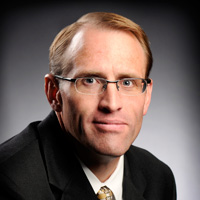Invest with Your Eyes Wide Open
Are you prepared for volatility? Before you make an investment, look carefully at its track record by asking these five questions.


Many investors are convinced that their investment portfolios should always go up. When returns don’t meet these unrealistic expectations, they tend to throw in the towel. It’s a mistake to sell good investments just because they are having a sluggish year or struggling through a bear market. You need to invest with your eyes wide open, knowing beforehandwhat to expect from your investments in both bull and bear markets. In most cases, when your investments take near-term dips, or fluctuate with the market, you should stay invested and hold on.
Most investors ask only one question before buying a portfolio of investments: “What will my return be?” Usually, they answer this by looking at recently posted one-year returns. Stopping at this question will likely leave you disappointed at some point during your investment journey.
In addition to knowing what the returns of your investments have been recently, be sure to ask the following:
From just $107.88 $24.99 for Kiplinger Personal Finance
Become a smarter, better informed investor. Subscribe from just $107.88 $24.99, plus get up to 4 Special Issues

Sign up for Kiplinger’s Free Newsletters
Profit and prosper with the best of expert advice on investing, taxes, retirement, personal finance and more - straight to your e-mail.
Profit and prosper with the best of expert advice - straight to your e-mail.
- What has the portfolio returned on average over the past one, three, five and 10 years?
- What was the best and worst three-month period during the past 10 years?
- What was the best and worst one-year period during the past 10 years?
- What was the best and worst three-year period during the past 10 years?
- How has the investment performed during past wars, bear markets, terrorist attacks and elections?
As an example, let’s answer these questions assuming you had a moderate portfolio consisting of 75% stocks and 25% bonds, such as a combo of Vanguard Total Stock Market Index Fund (Ticker: VTSMX) and Vanguard Total Bond Market Index Fund (VBMFX), rebalanced annually. You would have enjoyed an average return of 11.98%, 7.43%, 11.14%, and 7.06% over the past one, three, five and 10 years (according to Morningstar) for the period ending 8/31/2017. However, to obtain that 7.06% 10-year return you would have had to endure a worst three-month period watching the portfolio fall 23.45%, a worst one-year period with a drop of 32.03%, and a three-year period that lost 3.98% per year. For the 10-year period ending 8/31/2017, a $500,000 investment into this portfolio would now be worth $999,194.
Once you know the answers to these questions, you can then ask yourself an even more significant question: “If I want the long-term returns this investment or portfolio can produce, can I withstand the volatility?”
Without understanding this risk from the onset, volatility will likely get the best of you somewhere down the road.
Let’s investigate the market’s ups and downs during different periods.
The chart below compares eight different investors. All began investing on Jan. 1, 2008, with $500,000. The first four investors took withdrawals of $20,000 per year starting in 2008. The last four investors didn’t take any withdrawals. You’ll notice how much their portfolios fell in 2008-09 and how long it took to get back to $500,000. Based on this chart you can ask yourself which portfolio is closest to yours and whether or not you could handle similar volatility in the future. This was a really poor period in market history, however, you’ll notice that all the portfolios rebounded after 2008 and went on to provide modest returns.

Remember to take downturns in context. Listed below are the worst one-year results for different segments of the stock and bond markets from 1970 to 2016. For example, during the 1973–1974 recession, large-company stocks fell 37%. An investor would have been shortsighted to have sold a portfolio of large-company stocks after these poor-performing years. In thefollowing two years (1975–1976), large-company stocks provided patient investors with 37% and 24% returns, respectively. A $10,000 investment in an S&P 500-stock index fund starting in January 1970 would have grown to $1,002,783 by December 2016, a return of 10.30% per year.
Risk and Return of the Stock and Bond Markets
| 1970-2016 | ||
|---|---|---|
| Asset Class | Annual Rate of Return | Worst Year |
| Large-Company U.S. Stocks | 10% | -37% |
| Small-Company U.S. Stocks | 12% | -38% |
| International Stocks | 9% | -43% |
| Long-Term Corporate Bonds | 9% | -7% |
| Long-Term Government Bonds | 9% | -12% |
| U.S. Treasury Bills | 5% | 0.03% |
Let’s examine risk further by looking at drops occurring during market downturns, wars and terrorism. Again, the question in mind is: If we had similar volatility in the future, could I handle it?
Market Downturns
| S&P 500 Index | ||||
|---|---|---|---|---|
| Market Downturn | Row 0 - Cell 1 | Total Months | Total Return S&P 500 | Total Return One Year Later |
| Begin | End | Row 1 - Cell 2 | Row 1 - Cell 3 | Row 1 - Cell 4 |
| Jun 15 '48 | Jun 13 '49 | 12.1 | -20.6% | 42.1% |
| Aug 2 '56 | Oct 22 '57 | 14.9 | -21.5% | 31.0% |
| Dec 12 '61 | Jun 25 '62 | 6.5 | -27.8% | 32.3% |
| Feb 9 '66 | Oct 7 '66 | 8 | -22.2% | 33.2% |
| Nov 29 '68 | May 26 '70 | 18.1 | -36.1% | 43.7% |
| Jan 11 '73 | Oct 3 '74 | 21 | -48.2% | 38.0% |
| Nov 28 '80 | Aug 12 '82 | 20.7 | -27.1% | 58.3% |
| Aug 25 '87 | Dec 4 '87 | 3.4 | -33.5% | 22.8% |
| Mar 24 '00 | Sep 21 '01 | 18.2 | -36.8% | -13.7% |
| Jan 4 '02 | Oct 9 '02 | 9.3 | -33.8% | 33.7% |
| Oct 9 '07 | Nov 20 '08 | 13.6 | -51.9% | 45.0% |
| Jan 6 '09 | Mar 9 '09 | 2.1 | -27.6% | 68.6% |
| Average | Row 14 - Cell 1 | 12 | -32.3% | 36.2% |
War
| Dow Jones Industrial Average (DJIA) | Header Cell - Column 1 | Header Cell - Column 2 | Header Cell - Column 3 | Header Cell - Column 4 |
|---|---|---|---|---|
| War | Begin | End | Total Months | Change in DJIA |
| World War l | Apr '17 | Nov '18 | 20 | -19% |
| World War ll | Dec '41 | Aug '45 | 45 | 41% |
| Korean War | Jun '50 | Jul '53 | 37 | 20% |
| Vietnam War | Aug '64 | Jan '73 | 102 | 21% |
| Gulf War | Jan '91 | Feb '91 | 2 | 15% |
| Iraq War | Mar '03 | Dec '11 | 105 | 43% |
| Average | Row 7 - Cell 1 | Row 7 - Cell 2 | 52 | 20% |
Terrorism on U.S. Soil
| S&P 500 Index | ||
|---|---|---|
| Attacks of September 11, 2001 | Days after Attack | Total Return S&P 500 |
| Initial Market Reaction September 17, 2001 | 7 | -4.9% |
| Market Bottom after Attack September 21, 2001 | 11 | -11.6% |
| One Month after Attack October 11, 2001 | 30 | 0.4% |
| Two Months after Attack November 10, 2001 | 60 | 2.5% |
| Three Months after Attack December 10, 2001 | 90 | 4.3% |
Despite all the recessions, wars, terrorist attacks and market crashes, the stock market has been an excellent investment over the long term. The key is to stay invested through thick and thin. When you invest in a portfolio of stocks and bonds, be aware of the potential upside and downside associated with your investments. If you don’t understand the risks at the outset, youare more likely to react poorly during periodic market setbacks and get scared out of the market.
At the outset when you buy an investment, you should plan on worst-case scenarios occurring at some point. If you understand the risk from the beginning, you are more likely to stay invested for the long term and realize solid long-term gains. It is true that past performance isn’t guaranteed to repeat, but it does give us a historical indication of what to expect.
Profit and prosper with the best of Kiplinger's advice on investing, taxes, retirement, personal finance and much more. Delivered daily. Enter your email in the box and click Sign Me Up.

Ray LeVitre is an independent fee-only Certified Financial Adviser with over 20 years of financial services experience. In addition he is the founder of Net Worth Advisory Group and the author of "20 Retirement Decisions You Need to Make Right Now."
-
 Small Caps Can Only Lead Stocks So High: Stock Market Today
Small Caps Can Only Lead Stocks So High: Stock Market TodayThe main U.S. equity indexes were down for the week, but small-cap stocks look as healthy as they ever have.
-
 Ask the Editor: Tips for Filing Your 1040
Ask the Editor: Tips for Filing Your 1040Ask the Editor In this week's Ask the Editor Q&A, Joy Taylor answers questions on preparing and filing your 2025 Form 1040.
-
 Is Direct Primary Care Right for Your Health Needs?
Is Direct Primary Care Right for Your Health Needs?With the direct primary care model, you pay a membership fee for more personalized medical services.
-
 If You're in the 2% Club and Have a Pension, the 60/40 Portfolio Could Hold You Back
If You're in the 2% Club and Have a Pension, the 60/40 Portfolio Could Hold You BackIncome from your pension, savings and Social Security could provide the protection bonds usually offer, freeing you up for a more growth-oriented allocation.
-
 Bye-Bye, Snowbirds: Wealthy Americans Are Relocating Permanently for Retirement — and This Financial Adviser Can't Fault Their Logic
Bye-Bye, Snowbirds: Wealthy Americans Are Relocating Permanently for Retirement — and This Financial Adviser Can't Fault Their LogicWhy head south for the winter and pay for two properties when you can have a better lifestyle year-round in a less expensive state?
-
 Consider These 4 Tweaks to Your 2026 Financial Plan, Courtesy of a Financial Planner
Consider These 4 Tweaks to Your 2026 Financial Plan, Courtesy of a Financial PlannerThere's never a bad time to make or review a financial plan. But recent changes to the financial landscape might make it especially important to do so now.
-
 We Know You Hate Your Insurance, But Here's Why You Should Show It Some Love
We Know You Hate Your Insurance, But Here's Why You Should Show It Some LoveSure, it's pricey, the policies are confusing, and the claims process is slow, but insurance is essentially the friend who shows up during life's worst moments.
-
 Is a Caregiving Strategy — for Yourself and Others — Missing From Your Retirement Plan?
Is a Caregiving Strategy — for Yourself and Others — Missing From Your Retirement Plan?Millions of people over 65 care for grandkids, adult kids or aging parents and will also need care themselves. Building a caregiving strategy is crucial.
-
 6 Financially Savvy Power Moves for Women in 2026 (Prepare to Be in Charge!)
6 Financially Savvy Power Moves for Women in 2026 (Prepare to Be in Charge!)Don't let the day-to-day get in the way of long-term financial planning. Here's how to get organized — including a reminder to dream big about your future.
-
 Private Equity Is Fundamentally Changing: What Now for Investors and Business Owners?
Private Equity Is Fundamentally Changing: What Now for Investors and Business Owners?For 40 years, private equity enjoyed extraordinary returns thanks to falling rates and abundant credit. That's changed. What should PE firms and clients do now?
-
 I'm a Real Estate Expert: 2026 Marks a Seismic Shift in Tax Rules, and Investors Could Reap Millions in Rewards
I'm a Real Estate Expert: 2026 Marks a Seismic Shift in Tax Rules, and Investors Could Reap Millions in RewardsThree major tax strategies will align in 2026, creating unique opportunities for real estate investors to significantly grow their wealth. Here's how it works.